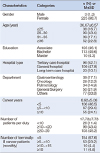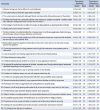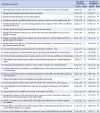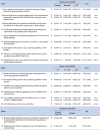Abstract
Purpose
The purpose of this study was to examine obstacles and supportive behaviors perceived or experienced by clinical nurses providing care for terminally ill cancer patients.
Methods
Beckstrand's survey questionnaire was translated into Korean and verified by an expert committee and through a preliminary study. A survey that used 26 questionnaire items on obstacles and 24 on supportive behaviors, was conducted among 228 registered nurses with more than one year of experience at medical-surgical general wards in a hospital.
Results
The highly-perceived and frequently-experienced obstacles in providing care for terminally-ill cancer patients were related to patients' uncontrollable pain or psychologically unstable family members. The highly-perceived and frequently-experienced supportive behaviors were related to caring family members or having supportive family members. However, nurses' perceptions or experiences of multiple obstacles and supportive behaviors differed by hospital type, career length, and department.
Conclusion
Nurses seem to be in need of training for pain management for terminal cancer patients and of family care in general. Highlyperceived and highly-experienced obstacles or highly-perceived but rarely-experienced supportive behaviors should be intervened without delay considering a hospital type or nurses' career length.
Figures and Tables
Table 1
General Characteristics of Study Participants (N=228)

Table 2
Perception & Experience of Obstacles in Providing Care for Terminally-Ill Cancer Patients (N=228)

Table 3
Intensity, Frequency for Supportive Behaviors in Providing Care for Terminally Ill Cancer Patients (N=228)

Table 4
Differences of Obstacles in Providing Care for Terminally Ill Cancer Patients by General Characteristics (N=228)

Table 5
Differences of Supportive Behaviors in Providing Care for Terminally Ill Cancer Patients by General Characteristics (N=228)

| Items | Department (M±SD) | t (p) | ||||
|---|---|---|---|---|---|---|
| Internal medicine | Surgery | |||||
| 19. A unit designed so that families have a place to go to grieve in private away from patients' rooms | E | 1.52±1.25 | 1.08±1.27 | 2.38 (.018) | ||
References
1. Statistics Korea. September 1, 2015. http://kostat.go.kr/portal/korea/kor_nw/2/6/2/index.board.
2. NECA. National Evidence-based Healthcare Collaborating Agency. October 1, 2009. http://www.neca.re.kr/center/paper/report_view.jsp?boardNo=GA&seq=5&q=63706167653d313626666c61673d3126626f6172644e6f3d47412 6736561726368436f6c3d2673656172636856616c3d2673656172636853 596561723d2673656172636845596561723d.
3. Cancer Control Act. June 30, 2016. http://www.law.go.kr/lsInfoP.do?lsiSeq=180766&efYd=20160804#0000.
4. Lee YO. A study of cancer unit nurses' stress from bereavement support [Master's thesis]. Seoul: Kyunghee Univ.;2004.
5. Lee SW, Lee YO, Heo DS, No KH, Kim HS, Kim SR, et al. The study on the medical and nursing service needs of the terminal cancer patients and their caregivers. J Korean Acad Nurs. 1998; 28(4):958–969.

6. Sohn SK. Needs of hospice care in families of the hospitalized terminal patients with cancer. Asian Oncol Nurs. 2009; 9(1):1–6.
7. Choi JY. Comparison of perceived nursing needs among oncology nurses, patients with non-terminal cancer and patients with terminal cancer. J Korean Acad Nurs. 2005; 35(6):1135–1143.

8. Youn YH. May 24, 2013. http://news.chosun.com/site/data/html_dir/2013/05/24/2013052403123.html.
9. Yun YH, Kwak M, Park SM. Chemotherapy use and associated factors among cancer patients near the end of life. Oncology. 2007; 72(3-4):164–171.

10. Jo KH, Kim MJ. The perception of suffering by hospice nurses. Korean Acad Fundam Nurs. 2001; 8(1):35–50.
11. Jo KH, Kim YK. The influencing factors on the degree of nurse's suffering experience caring for terminal cancer patient. Korean J Adult Nurs. 2004; 16(3):378–387.
12. Lee HR, Lee YO, Choi EY, Park YM. Comparison on stress and coping of bereavement care between nurses in the cancer unit and nurses in the general unit. Asian Oncol Nurs. 2007; 7(1):26–35.
13. Lee SL. Degrees of the burden and depression of nurses tending laststage cancer patients [Master's thesis]. Suwon: Ajou Univ.;2003.
14. Sin MH, Sin SR. Predictors of burnout among oncology nurses. Asian Oncol Nurs. 2003; 3(1):75–84.
15. Lee YS, Tea YS. The lived experience of the burnout of nurses working in oncology wards. Asian Oncol Nurs. 2012; 12(1):100–109.

16. Beckstrand RL, Callister L. Oncology nurse's perception of obstacles and supportive behaviors at the end of life. Oncol Nurs Forum. 2009; 36(4):446–453.

17. Guillemin F, Bombardier C, Beaton D. Cross-cultural adaptation of health-related quality of life measures: Literature review and proposed guidelines. J Clin Epidemiol. 1993; 46(12):1417–1432.

18. Hospice and Palliative care. August 2, 2016. http://hospice.cancer.go.kr/home/contentsInfo.do?menu_no=443&brd_mgrno=.
19. Choi ES. Content analysis with counseling cancer patients and their relatives in outpatient hospice office. Korean J Rehabil Nurs. 2005; 8(1):50–58.
20. Kwon SH, Yang SK, Park MH, Choi SO. Assessment for the needs to develop hospice training program for nurses. Korean J Hosp Palliat Care. 2008; 11(3):147–155.
21. Ministry of Health and Welfare. May 10, 2004. http://www.mohw.go.kr/front_new/jb/sjb030301vw.jsp?PAR_MENU_ID=03&MENU_ID=0320&CONT_SEQ=28246&page=1.
22. Beckstrand RL. Providing end-of-life care to patient: Critical care nurses' perceived obstacles and supportive behaviors. Am J Crit Care. 2005; 14(5):395–403.

23. Heaston S, Beckstrand RL. Emergency nurses' perceptions of obstacles and supportive behaviors in end-of-life care. J Emerg Nurs. 2006; 32(6):477–485.

24. Lee KH, Kwon HJ. An analytical study on the major obstacles in nursing care for the dying patients. Off J Res Med Sci Korea. 1983; 15(2):99–107.
27. Korea Health Industry Statistics. December 31, 2015. https://www.khiss.go.kr/treeManager.do?task=treeFrm&vw_cd=MT_ITITLE&list_id=358_E&htxt_code=125369725751510746110771881221239.




 PDF
PDF ePub
ePub Citation
Citation Print
Print


 XML Download
XML Download